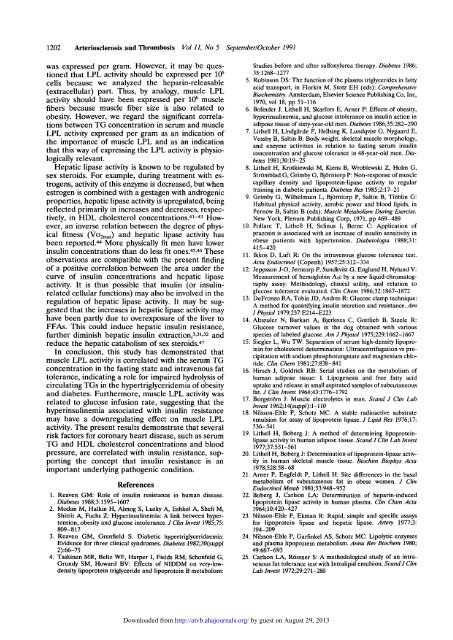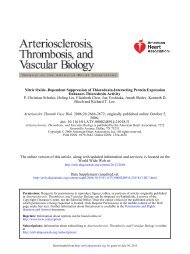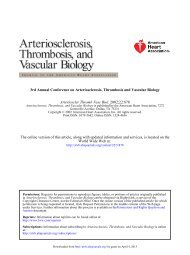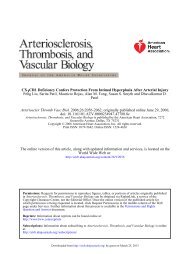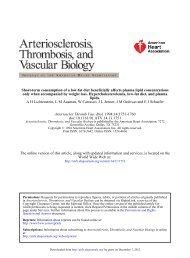Lipoprotein Lipase Activity in Skeletal Muscle Is Related to Insulin ...
Lipoprotein Lipase Activity in Skeletal Muscle Is Related to Insulin ...
Lipoprotein Lipase Activity in Skeletal Muscle Is Related to Insulin ...
Create successful ePaper yourself
Turn your PDF publications into a flip-book with our unique Google optimized e-Paper software.
1202 Arteriosclerosis and Thrombosis Vol 11, No 5 September/Oc<strong>to</strong>ber 1991<br />
was expressed per gram. However, it may be questioned<br />
that LPL activity should be expressed per 10 6<br />
cells because we analyzed the hepar<strong>in</strong>-releasable<br />
(extracellular) part. Thus, by analogy, muscle LPL<br />
activity should have been expressed per 10 6 muscle<br />
fibers because muscle fiber size is also related <strong>to</strong><br />
obesity. However, we regard the significant correlations<br />
between TG concentration <strong>in</strong> serum and muscle<br />
LPL activity expressed per gram as an <strong>in</strong>dication of<br />
the importance of muscle LPL and as an <strong>in</strong>dication<br />
that this way of express<strong>in</strong>g the LPL activity is physiologically<br />
relevant.<br />
Hepatic lipase activity is known <strong>to</strong> be regulated by<br />
sex steroids. For example, dur<strong>in</strong>g treatment with estrogens,<br />
activity of this enzyme is decreased, but when<br />
estrogen is comb<strong>in</strong>ed with a gestagen with androgenic<br />
properties, hepatic lipase activity is upregulated, be<strong>in</strong>g<br />
reflected primarily <strong>in</strong> <strong>in</strong>creases and decreases, respectively,<br />
<strong>in</strong> HDL cholesterol concentrations. 41 " 43 However,<br />
an <strong>in</strong>verse relation between the degree of physical<br />
fitness (Vo 2max ) and hepatic lipase activity has<br />
been reported. 44 More physically fit men have lower<br />
<strong>in</strong>sul<strong>in</strong> concentrations than do less fit ones. 4546 These<br />
observations are compatible with the present f<strong>in</strong>d<strong>in</strong>g<br />
of a positive correlation between the area under the<br />
curve of <strong>in</strong>sul<strong>in</strong> concentrations and hepatic lipase<br />
activity. It is thus possible that <strong>in</strong>sul<strong>in</strong> (or <strong>in</strong>sul<strong>in</strong>related<br />
cellular functions) may also be <strong>in</strong>volved <strong>in</strong> the<br />
regulation of hepatic lipase activity. It may be suggested<br />
that the <strong>in</strong>creases <strong>in</strong> hepatic lipase activity may<br />
have been partly due <strong>to</strong> overexposure of the liver <strong>to</strong><br />
FFAs. This could <strong>in</strong>duce hepatic <strong>in</strong>sul<strong>in</strong> resistance,<br />
further dim<strong>in</strong>ish hepatic <strong>in</strong>sul<strong>in</strong> extraction, 3 - 31 - 32 and<br />
reduce the hepatic catabolism of sex steroids. 47<br />
In conclusion, this study has demonstrated that<br />
muscle LPL activity is correlated with the serum TG<br />
concentration <strong>in</strong> the fast<strong>in</strong>g state and <strong>in</strong>travenous fat<br />
<strong>to</strong>lerance, <strong>in</strong>dicat<strong>in</strong>g a role for impaired hydrolysis of<br />
circulat<strong>in</strong>g TGs <strong>in</strong> the hypertriglyceridemia of obesity<br />
and diabetes. Furthermore, muscle LPL activity was<br />
related <strong>to</strong> glucose <strong>in</strong>fusion rate, suggest<strong>in</strong>g that the<br />
hyper<strong>in</strong>sul<strong>in</strong>emia associated with <strong>in</strong>sul<strong>in</strong> resistance<br />
may have a downregulat<strong>in</strong>g effect on muscle LPL<br />
activity. The present results demonstrate that several<br />
risk fac<strong>to</strong>rs for coronary heart disease, such as serum<br />
TG and HDL cholesterol concentrations and blood<br />
pressure, are correlated with <strong>in</strong>sul<strong>in</strong> resistance, support<strong>in</strong>g<br />
the concept that <strong>in</strong>sul<strong>in</strong> resistance is an<br />
important underly<strong>in</strong>g pathogenic condition.<br />
References<br />
1. Reaven GM: Role of <strong>in</strong>sul<strong>in</strong> resistance <strong>in</strong> human disease.<br />
Diabetes 1988;3:1595-1607<br />
2. Modan M, Halk<strong>in</strong> H, Almog S, Lusky A, Eshkol A, Shefi M,<br />
Shitrit A, Fuchs Z: Hyper<strong>in</strong>sul<strong>in</strong>emia: A l<strong>in</strong>k between hypertension,<br />
obesity and glucose <strong>in</strong><strong>to</strong>lerance. / Cl<strong>in</strong> Invest 1985;75:<br />
809-817<br />
3. Reaven GM, Grenfield S: Diabetic hypertriglyceridaemia:<br />
Evidence for three cl<strong>in</strong>ical syndromes. Diabetes 1982;30(suppl<br />
2):66-75<br />
4. Task<strong>in</strong>en MR, Beltz WF, Harper I, Fields RM, Schonfeld G,<br />
Grundy SM, Howard BV: Effects of NIDDM on very-lowdensity<br />
lipoprote<strong>in</strong> triglyceride and lipoprote<strong>in</strong> B metabolism:<br />
Studies before and after sulfonylurea therapy. Diabetes 1986;<br />
35:1268-1277<br />
5. Rob<strong>in</strong>son DS: The function of the plasma triglycerides <strong>in</strong> fatty<br />
acid transport, <strong>in</strong> Flork<strong>in</strong> M, S<strong>to</strong>tz EH (eds): Comprehensive<br />
Biochemistry. Amsterdam, Elsevier Science Publish<strong>in</strong>g Co, Inc,<br />
1970, vol 18, pp 51-116<br />
6. Bol<strong>in</strong>der J, Lithell H, Skarfors E, Arner P: Effects of obesity,<br />
hyper<strong>in</strong>sul<strong>in</strong>emia, and glucose <strong>in</strong><strong>to</strong>lerance on <strong>in</strong>sul<strong>in</strong> action <strong>in</strong><br />
adipose tissue of sixty-year-old men. Diabetes 1986;35:282-290<br />
7. Lithell H, L<strong>in</strong>dgarde F, Hells<strong>in</strong>g K, Lundqvist G, Nygaard E,<br />
Vessby B, Salt<strong>in</strong> B: Body weight, skeletal muscle morphology,<br />
and enzyme activities <strong>in</strong> relation <strong>to</strong> fast<strong>in</strong>g serum <strong>in</strong>sul<strong>in</strong><br />
concentration and glucose <strong>to</strong>lerance <strong>in</strong> 48-year-old men. Diabetes<br />
1981;30:19-25<br />
8. Lithell H, Krotkiewski M, Kiens B, Wroblewski Z, Holm G,<br />
Strdmblad G, Grimby G, Bjorn<strong>to</strong>rp P: Non-response of muscle<br />
capillary density and lipoprote<strong>in</strong>-lipase activity <strong>to</strong> regular<br />
tra<strong>in</strong><strong>in</strong>g <strong>in</strong> diabetic patients. Diabetes Res 1985;2:17-21<br />
9. Grimby G, Wilhelmsen L, Bjorn<strong>to</strong>rp P, Salt<strong>in</strong> B, Tibbl<strong>in</strong> G:<br />
Habitual physical activity, aerobic power and blood lipids, <strong>in</strong><br />
Pernow B, Salt<strong>in</strong> B (eds): <strong>Muscle</strong> Metabolism Dur<strong>in</strong>g Exercise.<br />
New York, Plenum Publish<strong>in</strong>g Corp, 1971, pp 469-489<br />
10. Pollare T, Lithell H, Sel<strong>in</strong>us I, Berne C: Application of<br />
prazos<strong>in</strong> is associated with an <strong>in</strong>crease of <strong>in</strong>sul<strong>in</strong> sensitivity <strong>in</strong><br />
obese patients with hypertension. Diabe<strong>to</strong>logia 1988;31:<br />
415-420<br />
11. Ikkos D, Luft R: On the <strong>in</strong>travenous glucose <strong>to</strong>lerance test.<br />
Ada Endocr<strong>in</strong>ol (Copenh) 1957;25:312-334<br />
12. Jeppsson J-O, Jern<strong>to</strong>rp P, Sundkvist G, Englund H, Nylund V:<br />
Measurement of hemoglob<strong>in</strong> A]C by a new liquid-chroma<strong>to</strong>graphy<br />
assay: Methodology, cl<strong>in</strong>ical utility, and relation <strong>to</strong><br />
glucose <strong>to</strong>lerance evaluated. Cl<strong>in</strong> Chem 1986;32:1867-1872<br />
13. DeFronzo RA, Tob<strong>in</strong> JD, Andres R: Glucose clamp technique:<br />
A method for quantify<strong>in</strong>g <strong>in</strong>sul<strong>in</strong> secretion and resistance. Am<br />
JPhysiol 1979;237:E214-E223<br />
14. Altszuler N, Barkari A, Bjerknes C, Gottlieb B, Steele R:<br />
Glucose turnover values <strong>in</strong> the dog obta<strong>in</strong>ed with various<br />
species of labeled glucose. Am J Physiol 1975;229:1662-1667<br />
15. Siegler L, Wu TW: Separation of serum high-density lipoprote<strong>in</strong><br />
for cholesterol determ<strong>in</strong>ation: Ultracentrifugation vs precipitation<br />
with sodium phosphotungstate and magnesium chloride.<br />
Cl<strong>in</strong> Chem 1981;27:838-841<br />
16. Hirsch J, Goldrick RB: Serial studies on the metabolism of<br />
human adipose tissue: I. Lipogenesis and free fatty acid<br />
uptake and release <strong>in</strong> small aspirated samples of subcutaneous<br />
fat. / Cl<strong>in</strong> Invest 1964;43:1776-1792<br />
17. Bergstrom J: <strong>Muscle</strong> electrolytes <strong>in</strong> man. Scand J Cl<strong>in</strong> Lab<br />
Invest 1962;14(suppl):l-110<br />
18. Nilsson-Ehle P, Schotz MC: A stable radioactive substrate<br />
emulsion for assay of lipoprote<strong>in</strong> lipase. / Lipid Res 1976;17:<br />
536-541<br />
19. Lithell H, Boberg J: A method of determ<strong>in</strong><strong>in</strong>g lipoprote<strong>in</strong>lipase<br />
activity <strong>in</strong> human adipose tissue. Scand J Cl<strong>in</strong> Lab Invest<br />
1977;37:551-561<br />
20. Lithell H, Boberg J: Determ<strong>in</strong>ation of lipoprote<strong>in</strong>-lipase activity<br />
<strong>in</strong> human skeletal muscle tissue. Biochim Biophys Ada<br />
1978;528:58-68<br />
21. Arner P, Engfeldt P, Lithell H: Site differences <strong>in</strong> the basal<br />
metabolism of subcutaneous fat <strong>in</strong> obese women. / Cl<strong>in</strong><br />
Endocr<strong>in</strong>ol Metab 1981;53:948-952<br />
22. Boberg J, Carlson LA: Determ<strong>in</strong>ation of hepar<strong>in</strong>-<strong>in</strong>duced<br />
lipoprote<strong>in</strong> lipase activity <strong>in</strong> human plasma. Cl<strong>in</strong> Chim Ada<br />
1964;10:420-427<br />
23. Nilsson-Ehle P, Ekman R: Rapid, simple and specific assays<br />
for lipoprote<strong>in</strong> lipase and hepatic lipase. Artery 1977;3:<br />
194-209<br />
24. Nilsson-Ehle P, Garf<strong>in</strong>kel AS, Schotz MC: Lipolytic enzymes<br />
and plasma lipoprote<strong>in</strong> metabolism. Annu Rev Biochem 1980;<br />
49:667-693<br />
25. Carlson LA, Rossner S: A methodological study of an <strong>in</strong>travenous<br />
fat <strong>to</strong>lerance test with Intralipid emulsion. Scand J Cl<strong>in</strong><br />
Lab Invest 1972;29:271-280<br />
Downloaded from http://atvb.ahajournals.org/ by guest on August 29, 2013


